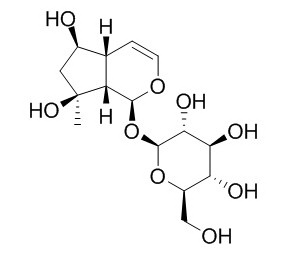Ajugol
Ajugol shows some trypanocidal potential against Trypanosoma brucei rhodesiense (IC50 values 29.3–73.0 ug/ml).
Inquire / Order:
manager@chemfaces.com
Technical Inquiries:
service@chemfaces.com
Tel:
+86-27-84237783
Fax:
+86-27-84254680
Address:
1 Building, No. 83, CheCheng Rd., Wuhan Economic and Technological Development Zone, Wuhan, Hubei 430056, PRC
Providing storage is as stated on the product vial and the vial is kept tightly sealed, the product can be stored for up to
24 months(2-8C).
Wherever possible, you should prepare and use solutions on the same day. However, if you need to make up stock solutions in advance, we recommend that you store the solution as aliquots in tightly sealed vials at -20C. Generally, these will be useable for up to two weeks. Before use, and prior to opening the vial we recommend that you allow your product to equilibrate to room temperature for at least 1 hour.
Need more advice on solubility, usage and handling? Please email to: service@chemfaces.com
The packaging of the product may have turned upside down during transportation, resulting in the natural compounds adhering to the neck or cap of the vial. take the vial out of its packaging and gently shake to let the compounds fall to the bottom of the vial. for liquid products, centrifuge at 200-500 RPM to gather the liquid at the bottom of the vial. try to avoid loss or contamination during handling.
Biomol Ther (Seoul).2020, 28(6):542-548.
Chemistry of Natural Compounds2019, 55(1):127-130
Process Biochemistry2019, 85:106-115
Rev. Chim.2020, 71(3),558-564
Phytomedicine.2018, 40:37-47
Food Chem Toxicol.2020, 135:110863
Pak J Pharm Sci.2018, 31:311-315
J Ethnopharmacol.2024, 333:118415.
LWT2020, 126:109313
VNU Journal of Science: Med.& Pharm. Sci.2022, 38(2):2588-1132.
Related and Featured Products
Phytochemistry, 2005, 66(3):355-62.
Anti-protozoal and plasmodial FabI enzyme inhibiting metabolites of Scrophularia lepidota roots.[Pubmed:
15680992 ]
The ethanolic root extract of Scrophularia lepidota, an endemic plant of the Turkish flora, has been investigated for its anti-protozoal and inhibitory effect towards plasmodial enoyl-ACP reductase (FabI), a key enzyme of fatty acid biosynthesis in Plasmodium falciparum.
METHODS AND RESULTS:
Chromatographic separation of the extract yielded 10 iridoids (1-10), two of which are new, and a known phenylethanoid glycoside (11). The structures of the new compounds were determined as 3,4-dihydro-methylcatalpol (8) and 6-O-[4''-O-trans-(3,4-dimethoxycinnamoyl)-alpha-L-rhamnopyranosyl]aucubin (scrolepidoside, 9) by spectroscopic means. The remaining metabolites were characterized as catalpol (1), 6-O-methylcatalpol (2), aucubin (3), 6-O-alpha-L-rhamnopyranosyl-aucubin (sinuatol, 4), 6-O-beta-D-xylopyranosylaucubin (5), Ajugol (6), ajugoside (7), an iridoid-related aglycone (10) and angoroside C (11). Nine isolates were active against Leishmania donovani, with the new compound 9 being most potent (IC50 6.1 microg/ml). Except for 4, all pure compounds revealed some trypanocidal potential against Trypanosoma brucei rhodesiense (IC50 values 29.3-73.0 microg/ml). Only compound 10 showed moderate anti-plasmodial (IC50 40.6 microg/ml) and FabI enzyme inhibitory activity (IC50 100 microg/ml). 10 is the second natural product inhibiting the fatty acid biosynthesis of Plasmodium falciparum.
Cancer Lett . 2017 Sep 10;403:195-205.
Bruceine D inhibits hepatocellular carcinoma growth by targeting β-catenin/jagged1 pathways[Pubmed:
28645563]
Abstract
Hepatocellular carcinoma (HCC) is known for high mortality and limited available treatments. Aberrant activation of the Wnt and Notch signaling pathways is critical to liver carcinogenesis and progression. Here, we identified a small molecule, bruceine D (BD), as a Notch inhibitor, using an RBP-Jκ-dependent luciferase-reporter system. BD significantly inhibited liver tumor growth and enhanced the therapeutic effects of sorafenib in various murine HCC models. Mechanistically, BD promotes proteasomal degradation of β-catenin and the depletion of its nuclear accumulation, which in turn disrupts the Wnt/β-catenin-dependent transcription of the Notch ligand Jagged1 in HCC. Our findings provide important information about a novel Wnt/Notch crosstalk inhibitor that is synergistic with sorafenib for treatment of HCC, and therefore have high clinical impact.
Keywords: BD; Hepatocellular carcinoma; Jagged1; Sorafenib; Wnt/Notch crosstalk; β-catenin.
Volume 23, Issue 11, 1982, Pages 1215-1216
Structural revision of ajugol and myoporoside[Reference:
WebLink]
METHODS AND RESULTS:
An analysis of existing 13C NMR data shows that the structures reported for the iridoid glucosides Ajugol and myoporoside should be interchanged.
CONCLUSIONS:
Consequently, the structures of ajugoside and laterioside, both acyl-derivatives of Ajugol, as well as that of 8-O-acetyl-myoporoside need revision.



